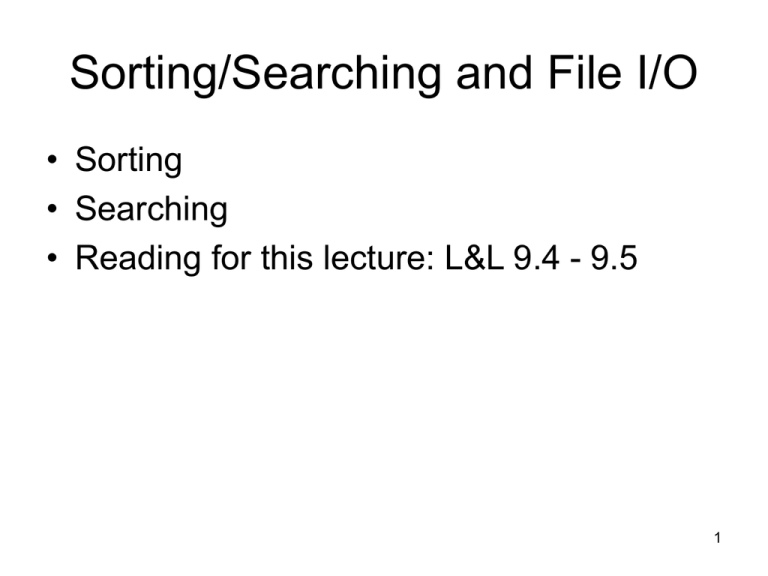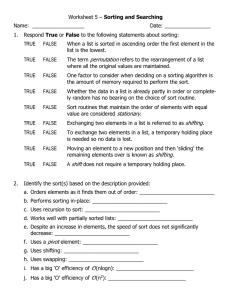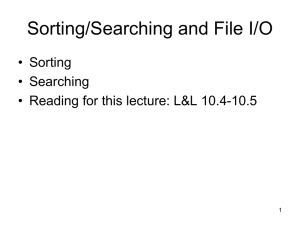Sorting/Searching and File I/O • Sorting • Searching
advertisement

Sorting/Searching and File I/O • Sorting • Searching • Reading for this lecture: L&L 9.4 - 9.5 1 Sorting • Sorting is the process of arranging a list of items in a particular order • The sorting process is based on specific value(s) – Sorting a list of test scores in ascending numeric order – Sorting a list of people alphabetically by last name • There are many algorithms, which vary in efficiency, for sorting a list of items • We will examine two specific algorithms: – Selection Sort – Insertion Sort 2 Selection Sort • The approach of Selection Sort: – Select a value and put it in its final place in the list – Repeat for all other values • In more detail: – Find the smallest value in the list – Switch it with the value in the first position – Find the next smallest value in the list – Switch it with the value in the second position – Repeat until all values are in their proper places 3 Selection Sort • An example: original: smallest is smallest is smallest is smallest is 1: 2: 3: 6: 3 1 1 1 1 9 9 2 2 2 6 6 6 3 3 1 3 3 6 6 2 2 9 9 9 • Each time, the smallest remaining value is found and exchanged with the element in the "next" position to be filled 4 Swapping Two Values • The processing of the selection sort algorithm includes the swapping of two values • Swapping requires three assignment statements and a temporary storage location of the same type as the data being swapped: int first = 1, second = 2; int temp = first; first = second; // == 2 now second = temp; // == 1 now 5 Selection Sort • The sorting method doesn't "care" what type of object it is sorting, it just needs to be able to call the compareTo method of that object • That is guaranteed by using Comparable as the parameter type passed to the sorting method • Each Comparable class has a compareTo method that determines what it means for one object of that class to be “less than another” • See PhoneList.java (page 500) • See Sorting.java (page 501), specifically the selectionSort method • See Contact.java (page 503) 6 Insertion Sort • The approach of Insertion Sort: – Pick any item and insert it into its proper place in a sorted sublist – Repeat until all items have been inserted • In more detail: – Consider the first item to be a sorted sublist (of one item) – Insert the second item into the sorted sublist, shifting the first item as needed to make room to insert the new addition – Insert the third item into the sorted sublist (of two items), shifting items as necessary – Repeat until all values are inserted into their proper 7 positions Insertion Sort • An example: original: 3 9 6 1 2 insert 9: 3 9 6 1 2 insert 6: 3 6 9 1 2 insert 1: 1 3 6 9 2 insert 2: 1 2 3 6 9 • See Sorting.java (page 501), specifically the insertionSort method 8 Comparing Sorts • The Selection and Insertion sort algorithms are similar in efficiency • They both have outer loops that scan all elements, and inner loops that compare the value of the outer loop with almost all values in the list • Approximately n2 number of comparisons are made to sort a list of size n • We therefore say that these sorts are of order n2 • Other sorts are more efficient: order n log2 n 9 Searching • Searching is the process of finding a target element within a group of items called the search pool • The target may or may not be in the search pool • We want to perform the search efficiently, minimizing the number of comparisons • Let's look at two classic searching approaches: linear search and binary search • As we did with sorting, we'll implement the searches with polymorphic Comparable parameters 10 Linear Search • A linear search begins at one end of a list and examines each element in turn • Eventually, either the item is found or the end of the list is encountered • See PhoneList2.java (page 508) • See Searching.java (page 509), specifically the linearSearch method 11 Binary Search • A binary search assumes the list of items in the search pool is sorted • It eliminates a large part of the search pool with a single comparison • A binary search first examines the middle element of the list -- if it matches the target, the search is over • If it doesn't, only half of the remaining elements need be searched • Since they are sorted, the target can only be in one half of the other 12 Binary Search • The process continues by comparing the target to the middle element of the remaining viable candidates • Each comparison eliminates approximately half of the remaining data • Eventually, the target is found or there are no remaining viable candidates (and the target has not been found) • See PhoneList2.java (page 508) • See Searching.java (page 509), specifically the binarySearch method 13 Binary Versus Linear Search • The efficiency of binary search is good for the retrieval of data from a sorted group • However, the group must be sorted initially • As items are added to the group, it must be kept in sorted order • The sorting process creates inefficiency • If you add data to a group much more often than you search it, it may be worse to use a binary search than a linear search 14




